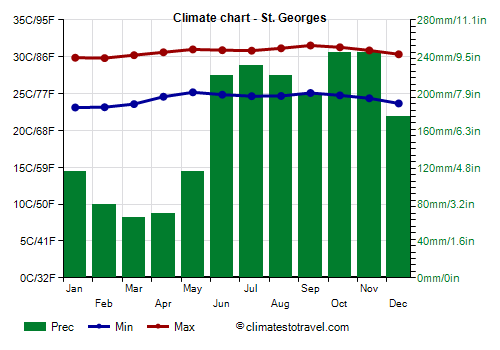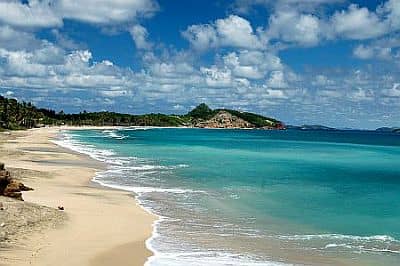Select units of measurement for the temperature and rainfall tables (metric or imperial).
Average weather, temperature, rainfall, sunshine
The climate of Grenada is
tropical, hot and humid all year round, with a relatively cool season from December to March and a hot, sultry and rainy season from June to November.
The
trade winds blow all year round, reducing the sensation of heat, usually from the north-east, although in the hot period they can blow from the east or the south-east.
Grenada is a country of the Lesser Antilles, which includes the main island, located at 12 degrees north latitude (therefore, halfway between the Equator and the Tropic of Cancer), plus the smaller
southern Grenadines (Carriacou and Petite Martinique, plus some uninhabited islands), located to the north.
The interior of the main island is occupied by
hills and low mountains, whose highest point is St. Catherine volcano, 840 meters (2,760 feet) high, where a rainforest grows, and we can speak of equatorial climate: precipitation is very abundant, up to 3,500 mm (138 in) per year, the sky is often cloudy, and the temperature is a bit lower.
The climate in detail
Temperature and rain

On the coast,
precipitation depends above all on the proximity to the hills. In the capital,
Saint George's, on the south-western coast, almost 2,000 millimeters (78 inches) of rain fall per year, of which more than 100 mm (4 in) fall per month from May to January, and more than 200 mm (8 in) from June to November. The least rainy months are March and April, with 65/70 mm (2.6/2.8 in) per month on average.
In Point Salines, in the southwestern tip of the main island, south of St. George's, where the Maurice Bishop
International Airport is located (from which the climate data is taken), being that it's a flat area and away from inland elevations, precipitation drops to 1,150 mm (45 in) per year as well.
Here the
average temperature varies between around 26.5 °C (79.5 °F) in January and February, to around 28 °C (82.5 °F) from May to October.
The rains in Grenada and the Grenadines usually occur throughout the year in the form of
downpours or thunderstorms, which could be intense, but generally do not last long, so they do not reduce too much the sunshine hours; sometimes, however, there may be a more intense wave of bad weather.
In fact, the amount of
sunshine is good all year round, at least on the coast.

Sea temperature
The sea in Grenada is warm enough to swim in throughout the year: the water temperature ranges from 27 °C (81 °F) in the January-April period to 29 °C (84 °F) in September and October, as we can see in the following table.
Hurricanes
The greatest danger comes from tropical storms and cyclones, called
hurricanes in the Caribbean area, which may pass over the area from June to November, though they are most likely from August to October.
Grenada is located in the
southernmost part of the hurricane belt, so it is rarely affected by them, although it may sometimes be affected, as happened with the following hurricanes: Hazel in October 1954, Janet in late September 1955, Joan in October 1988, Ivan in September 2004, and Felix in early September 2007.
When to go
The best time to visit Grenada is from
February to April, since it is the driest period of the year, but all in all, January is an acceptable month as well.
What to pack
All year round: bring
light, loose-fitting clothes of natural fabric, and possibly a light sweatshirt and a light raincoat for thunderstorms; possibly a light sweatshirt for the evening from December to March.
When going to the reef, you can bring snorkeling equipment, including water shoes or rubber-soled shoes.
When going hiking in the mountains, bring a light sweatshirt, a raincoat and hiking shoes.
Climate data - Grenada
| St Georges |
|---|
|
| Jan | Feb | Mar | Apr | May | Jun | Jul | Aug | Sep | Oct | Nov | Dec |
|---|
| Min temp. | 23 | 23 | 24 | 25 | 25 | 25 | 25 | 25 | 25 | 25 | 24 | 24 |
|---|
| Max temp. | 30 | 30 | 30 | 30 | 31 | 31 | 31 | 31 | 31 | 31 | 31 | 30 |
|---|
| Precip. | 65 | 40 | 25 | 35 | 55 | 125 | 125 | 145 | 120 | 150 | 165 | 105 |
|---|
| Prec. days | 11 | 7 | 5 | 5 | 7 | 14 | 15 | 15 | 11 | 14 | 15 | 12 |
|---|
| Humidity | 79% | 78% | 77% | 78% | 79% | 81% | 82% | 83% | 82% | 83% | 84% | 81% |
|---|
| Day length | 12 | 12 | 12 | 12 | 13 | 13 | 13 | 12 | 12 | 12 | 12 | 11 |
|---|
| Sun hours | 9 | 9 | 9 | 9 | 8 | 8 | 8 | 8 | 8 | 8 | 8 | 8 |
|---|
| Sea temp | 27 | 27 | 27 | 27 | 28 | 28 | 28 | 29 | 29 | 29 | 28 | 28 |
|---|